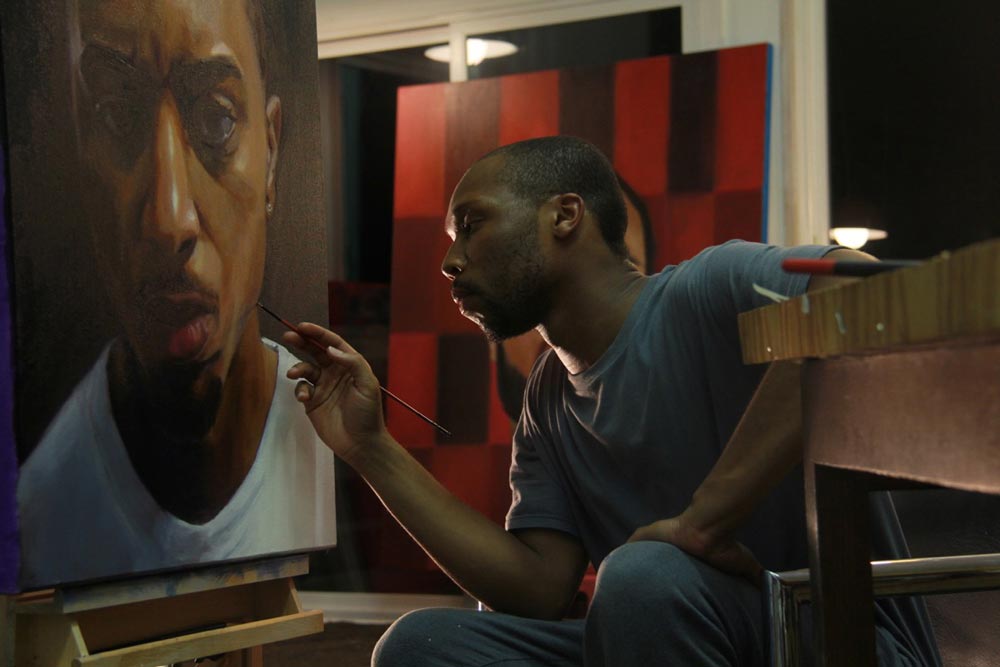Durham, NC
PAINTING
Of the hundreds of portraits artist William Paul Thomas has painted, he says the large scale oil painting of his grandmother Carolyn Thomas is probably his favorite, and not just because it was selected by Chicago’s Museum of Science and Industry to be featured in its annual Black Creativity exhibition. The affinity is more about his love for his grandmother and an appreciation for the influential role she has played in his journey as an artist, starting with his earliest memory of making art — under her roof.
In his uncle Michael’s childhood bedroom, by pressing down on the muslin fabric his grandmother had used to cover the walls, the young Thomas discovered what she was covering up. His uncle, who had a real talent for drawing, had filled the walls with his artwork. Thomas was in awe. Perhaps because he was learning to read at the time, the word B-A-S-S caught his attention, so he began to trace over it. Though he did get in a good bit of trouble for writing on the muslin, his grandmother would soon become one of the biggest supporters of his art. By asking — and sometimes requiring — him to make art as a contribution to various projects for the nonprofit organization she ran, his grandmother encouraged him to find purpose with and for his artistic pursuits.

ARTIST'S NOTE
“I’m really inspired and curious about people in general, and painting just serves as an excuse to do that. Is there a relationship that I'd like to strengthen or a person I like to get to know better? Painting is a mechanism to do that.”
“I think it inspired me to really consider the layers of significance that are built into making art,” explains Thomas, who would go on to receive a BFA from the University of Wisconsin and an MFA from UNC Chapel Hill. “More than just pretty pictures, making art can educate, inspire and cultivate a richer understanding of our cultural experiences as people.” For the past five years, the artist has continued to explore that idea — with a multimedia project called Mood Swings featuring portraits of black men and women along with interviews about what brings them joy, and another project called Cyanosis.
The portrait series, which gets its name from a medical term used to describe blueness of the skin caused by insufficiently oxygenated blood, began with a painting of the artist’s young nephew, Michael. Thomas painted half of Michael's face blue as a way of emphasizing his brown skin, to make his complexion part of the content and the conversation. The artist says that the underlying, more universal idea behind the half-blue portraits is the fact that we are all dealing with some kind of conflict, trauma or adversity that the people we engage with day-to-day might not know anything about. And yet, he marvels, many of us still manage to present our best selves to the world. “My question through those paintings is: what would it look like if that trauma or adversity was shown on the skin?” says Thomas. “Would it invite people to be kinder to each other?”
![]()

How would you describe your portraits that include text?
“I paint representations of disembodied heads of people in my social circle and sometimes scrawl text directly over their likenesses. That text is often tinged with dry humor, at times it is politically incorrect, and is regularly derived from the spoken vernacular of the communities I have lived in.”
How do you choose models for your paintings?
“I choose specific models as a way of recognizing their significance in my life’s path. I relish being able to honor everyday people through making images. We regularly celebrate women and men of prominence in mass media, so I take advantage of the opportunity to highlight the people that impact me on a more direct level than any untouchable celebrity or distant historical figure could.”
Can you point to an event that was pivotal to the trajectory of your career?
“I spent a year as the Brock Family Visiting Instructor teaching painting at Duke University while Professor Beverly McIver was working at the American Academy in Rome. That was the best job I ever had, and it helped generate a number of other pivotal opportunities after my contract ended.”
What artist would you love to meet what would be your first question?
“Donald Glover. How and when did you realize all the brilliance you had to offer the world?”





